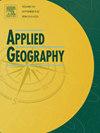The impact of sub-pixel scale urban function on urban heat island: Insights derived from its decomposition
IF 4
2区 地球科学
Q1 GEOGRAPHY
引用次数: 0
Abstract
Urban functional land use significantly impacts the Urban Heat Island (UHI) effect. While many studies have explored this relationship, research on mixed functional land use and its effects on UHI is limited. This study uses remote sensing imagery and multisource data to identify urban mixed-function structures at the sub-pixel scale. Focusing on the Wuhan Urban Agglomeration (WUA), the study utilizes eXtreme Gradient Boosting (XGBoost) to establish the mapping relationship between mixed land use and UHI. Shapley Additive exPlanations (SHAP) method is applied to explain the mechanism by which mixed functional land use affects UHI. The findings show accuracies exceeding 80% in identifying mixed-function structures, validating the effectiveness of the mixed pixel decomposition method. SHAP analysis reveals that the abundance of industrial land, residential land, commercial land, and public land all positively correlate with UHI. Industrial land has the highest abundance impact, followed by residential land, with public and commercial land having the least. Moreover, SHAP plots show that combining high-fraction industrial and residential land intensifies UHI, as does mixing residential with high-fraction commercial land. This study provides crucial insights for urban planning and sustainable development.
亚像元尺度城市功能对城市热岛的影响:基于分解的启示
城市功能性土地利用对城市热岛效应有显著影响。虽然许多研究已经探讨了这种关系,但关于混合功能土地利用及其对城市热岛影响的研究有限。本研究利用遥感影像和多源数据对亚像元尺度的城市混合功能结构进行识别。以武汉城市群为研究对象,利用极限梯度增强(XGBoost)方法建立了混合土地利用与城市热岛指数的映射关系。采用Shapley加性解释(SHAP)方法解释了混合功能土地利用对城市热岛的影响机制。结果表明,混合功能结构的识别准确率超过80%,验证了混合像元分解方法的有效性。SHAP分析表明,工业用地、住宅用地、商业用地和公共用地的丰度均与城市热岛指数呈正相关。工业用地的丰度影响最大,其次是居住用地,公共用地和商业用地的丰度影响最小。此外,SHAP地块显示,高比例工业用地和住宅用地的结合加剧了热岛指数,住宅用地和高比例商业用地的混合也加剧了热岛指数。这项研究为城市规划和可持续发展提供了重要的见解。
本文章由计算机程序翻译,如有差异,请以英文原文为准。
求助全文
约1分钟内获得全文
求助全文
来源期刊

Applied Geography
GEOGRAPHY-
CiteScore
8.00
自引率
2.00%
发文量
134
期刊介绍:
Applied Geography is a journal devoted to the publication of research which utilizes geographic approaches (human, physical, nature-society and GIScience) to resolve human problems that have a spatial dimension. These problems may be related to the assessment, management and allocation of the world physical and/or human resources. The underlying rationale of the journal is that only through a clear understanding of the relevant societal, physical, and coupled natural-humans systems can we resolve such problems. Papers are invited on any theme involving the application of geographical theory and methodology in the resolution of human problems.
 求助内容:
求助内容: 应助结果提醒方式:
应助结果提醒方式:


